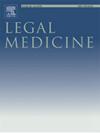Challenges of the minimum postmortem interval (PMImin) estimation in forensic scenarios: Is dental histology an alternative?
IF 1.3
4区 医学
Q3 MEDICINE, LEGAL
引用次数: 0
Abstract
Postmortem interval (PMI) estimates the time since death. Teeth are perennial elements capable of remaining intact in taphonomic environmental circumstances. The objective was to evaluate the feasibility of estimating the minimum postmortem interval (PMImin) through histological analyses of dental tissues exposed to burial and drowning conditions, simulating common scenarios in forensic practice. A total of n = 99 teeth were analyzed and divided into four groups: control (T0), one month (T1), three months (T2), and six months (T3). The control sample comprised 10 teeth, while T1, T2 e T3 were divided into three different subgroups: controlled environment, buried, and drowned. For each subgroup, ten samples were used. Following exposure to taphonomic conditions, the specimens were processed, and histological sections were obtained. The two-way ANOVA test and the Tukey’s post-hoc test were employed for the quantitative analysis of dentin collagen fibrils, revealing statistically significant differences (α = 5 %). This allowed for the estimation of the PMImin at three months by observing pixel counts exceeding 13e+05 in drowned teeth and greater than 8e+05 in buried teeth. Qualitative analysis revealed that the PMImin of drowned teeth was estimated at one month due to the absence of the periodontal ligament (PDL) and at six months due to the absence of predentin and partial degradation of the cementum. For buried teeth, the three-month PMImin was indicated by the absence of PDL and partial cementum degradation. The absence of pulp and remnants of predentin characterized the six-month PMImin. Qualitative and quantitative histological characteristics and parameters are potential to estimate PMImin in forensic scenarios spanning up to six months.
法医场景中最小死后间隔(PMImin)估算所面临的挑战:牙科组织学是一种替代方法吗?
死后间隔(PMI)估计的是死亡后的时间。牙齿是一种常年存在的元素,能够在不同的环境条件下保持完整。研究的目的是模拟法医实践中的常见情况,通过对暴露在掩埋和溺水条件下的牙齿组织进行组织学分析,评估估算最小死后间隔时间(PMImin)的可行性。共分析了 n = 99 颗牙齿,并将其分为四组:对照组(T0)、一个月组(T1)、三个月组(T2)和六个月组(T3)。对照组样本包括 10 颗牙齿,而 T1、T2 和 T3 则分为三个不同的子组:受控环境组、埋藏组和溺水组。每个分组使用 10 个样本。在暴露于岩石学条件下后,对标本进行处理,并获得组织学切片。在对牙本质胶原纤维进行定量分析时,采用了双向方差分析和 Tukey 后检验,结果显示差异具有统计学意义(α = 5%)。通过观察被淹没牙齿的像素计数超过 13e+05 和被掩埋牙齿的像素计数超过 8e+05,可以估算出三个月时的 PMImin。定性分析显示,由于没有牙周韧带 (PDL),溺水牙的 PMImin 是在一个月时估算的,而六个月时的 PMImin 则是由于没有前牙素和部分骨水泥降解而估算的。对于埋入式牙齿,三个月的 PMImin 是由牙周韧带缺失和部分牙骨质退化决定的。六个月 PMImin 的特征是没有牙髓和前牙素残留。定性和定量的组织学特征和参数有可能在长达六个月的法医场景中估算出PMImin。
本文章由计算机程序翻译,如有差异,请以英文原文为准。
求助全文
约1分钟内获得全文
求助全文
来源期刊

Legal Medicine
Nursing-Issues, Ethics and Legal Aspects
CiteScore
2.80
自引率
6.70%
发文量
119
审稿时长
7.9 weeks
期刊介绍:
Legal Medicine provides an international forum for the publication of original articles, reviews and correspondence on subjects that cover practical and theoretical areas of interest relating to the wide range of legal medicine.
Subjects covered include forensic pathology, toxicology, odontology, anthropology, criminalistics, immunochemistry, hemogenetics and forensic aspects of biological science with emphasis on DNA analysis and molecular biology. Submissions dealing with medicolegal problems such as malpractice, insurance, child abuse or ethics in medical practice are also acceptable.
 求助内容:
求助内容: 应助结果提醒方式:
应助结果提醒方式:


